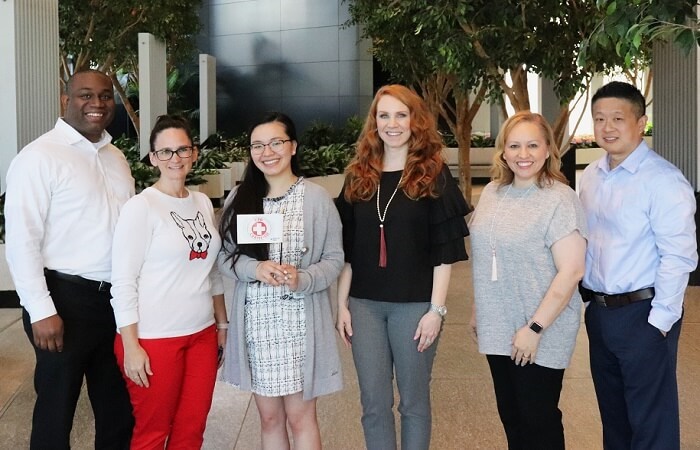Raising a Flag for Safety
Company makes it easy to identify those willing and able to help in an emergency.
Company makes it easy to identify those willing and able to help in an emergency.

When a CenterPoint Energy contractor took a hard fall in the company’s Houston corporate office May 22, Lisa Lopez was immediately approached for assistance.
Lopez, an instructional development specialist at CenterPoint Energy, is certified in first aid and CPR. She is also certified to use an AED, or automated external defibrillator. This means Lopez can – and does – display a "CPR Certified” flag in her cubicle, which communicates to her coworkers that she can be called on to help in an emergency.
That is the exact scenario that played out in May.
“Afterwards, in talking with the crowd of people who witnessed the event, the first thing they remembered to do – and in a panic – was to find someone with a flag and/or someone on the safety team,” Lopez said. “This is a testament to how effective our socialization of the CPR flags has been.”
CenterPoint Energy launched its CPR Certified flag program in 2017, developed by the 17th Floor Safety Committee in CenterPoint Energy’s Houston office.
It took an initial idea of posting an emergency-ready personnel seating chart to another level. Fellow instructional development specialist Christopher Hudson explained how the flag program at CenterPoint Energy makes first aid, CPR and AED certification more identifiable in the workplace, noting it’s typically hard to determine who has those skills.
“You get certified, a card goes in your wallet. No one sees that,” he said. “You don’t have a special badge you wear or a special uniform you wear. So, people just don’t know. And, even if you’re trained, that doesn’t tell people you’re willing to help, right? It doesn’t tell people your mindset or your desire. It just tells people your skills or your knowledge. So, the flag is a good way to say, yes, I know what to do, and as long as I know … if that situation arises, I’d be willing to help.”
After upper management at CenterPoint Energy approved the idea, employees who were willing to post a flag were identified, and flags were purchased and installed. Care was taken to ensure the flags were viewable regardless of directional approach or employee height.
Initially, 12 employees signed up to display a “CPR Certified” flag at CenterPoint Energy. Since that time, more than 150 additional flags have been rolled out in the company’s various offices. Sign-ups for first aid, CPR and AED courses offered through the company also have increased.
In addition, safety bulletin boards are positioned in high traffic areas to communicate where fire extinguishers and AED machines are located, as well as monthly Safety First messages, which are emailed to employees at the beginning of each month.
Hudson said the Safety First messages usually address top-of-mind and seasonal safety issues.
“A lot of times what serves as our major resource for that is the National Safety Council safety calendar,” he said. “We kind of use that as a guide a lot of times to determine what’s going to be our Safety First message.”
Christi Gilchrist, manager of organizational readiness at CenterPoint Energy, said the relatively low cost of the flag and bulletin board safety measures means the programs could easily be replicated in almost any office, noting one doesn’t have to be a safety professional to take the idea and run with it.
“The safety initiatives we implemented … are a true testament to the idea that one doesn’t have to be a safety expert to promote safety within the workplace,” she said. “These smaller scale, yet very impactful safety practices can be very easily replicated on a much larger scale. We believe that safe and creative work practices are contagious and are excited to have been a part of that contagion here at CenterPoint Energy.”
To date, Lopez is the only employee with a “CPR Certified” flag at CenterPoint Energy who has been called upon to use her first aid training in the office, but many employees are ready, should future needs arise. Just look for the flags, and you’ll know who can help.
If you liked this post, sign up for a once-a-month digest of our best posts from Safety First.
With a century-long legacy, the National Safety Council is a global center for safety expertise. Let's work together to align resources. We look forward to learning about ways we can join efforts to expand safety everywhere!
There are no items in your cart